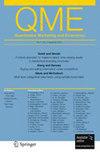Risk transfer versus cost reduction on two-sided microfinance platforms
IF 1.1
4区 管理学
Q3 BUSINESS
引用次数: 15
Abstract
Microfinance can be an important tool for fighting global poverty by increasing access to loans and possibly lowering interest rates through microlending. However, the dominant mechanism used by online microfinance platforms, in which intermediaries administer loans, has profound implications for borrowers. Using an analytical model of microlending with intermediaries who disburse and service loans, we demonstrate that profit-maximizing intermediaries have an incentive to increase interest rates because much of the default risk is transferred to lenders. Borrower and lender interest rate elasticities can serve as disciplining mechanisms to mitigate this interest rate increase. Using data from Kiva.org, we find that interest rates do not affect lender decisions, which removes one of these disciplining mechanisms. Interest rates are high, around 38% on Kiva. In contrast, on an alternative microfinance platform that does not use intermediaries, Zidisha, interest rates are only around 10%, highlighting the dramatic impact of intermediaries on interest rates. We propose an alternative loan payback mechanism that still allows microfinance platforms to use intermediaries, while removing the incentive to increase interest rates due to the transfer of risk to lenders.双边小额信贷平台的风险转移与成本降低
小额信贷可以增加获得贷款的机会,并可能通过小额贷款降低利率,从而成为消除全球贫困的重要工具。然而,在线小额信贷平台使用的主要机制——中介机构管理贷款——对借款人有着深远的影响。通过对发放和服务贷款的中介机构的小额贷款分析模型,我们证明了利润最大化的中介机构有动机提高利率,因为大部分违约风险转移给了贷款人。借款人和贷款人的利率弹性可以作为约束机制,以缓解这种利率增长。使用Kiva.org的数据,我们发现利率不影响贷款人的决定,这消除了这些约束机制之一。利率很高,Kiva的利率约为38%。相比之下,在另一个不使用中介机构的小额信贷平台“子地沙”上,利率仅在10%左右,凸显了中介机构对利率的巨大影响。我们提出了一种替代的贷款偿还机制,该机制仍然允许小额信贷平台使用中介机构,同时消除了由于将风险转移给贷款人而提高利率的动机。
本文章由计算机程序翻译,如有差异,请以英文原文为准。
求助全文
约1分钟内获得全文
求助全文
来源期刊

Qme-Quantitative Marketing and Economics
Multiple-
CiteScore
2.30
自引率
10.50%
发文量
13
期刊介绍:
Quantitative Marketing and Economics (QME) publishes research in the intersection of Marketing, Economics and Statistics. Our focus is on important applied problems of relevance to marketing using a quantitative approach. We define marketing broadly as the study of the interface between firms, competitors and consumers. This includes but is not limited to consumer preferences, consumer demand and decision-making, strategic interaction of firms, pricing, promotion, targeting, product design/positioning, and channel issues. We embrace a wide variety of research methods including applied economic theory, econometrics and statistical methods. Empirical research using primary, secondary or experimental data is also encouraged. Officially cited as: Quant Mark Econ
 求助内容:
求助内容: 应助结果提醒方式:
应助结果提醒方式:


